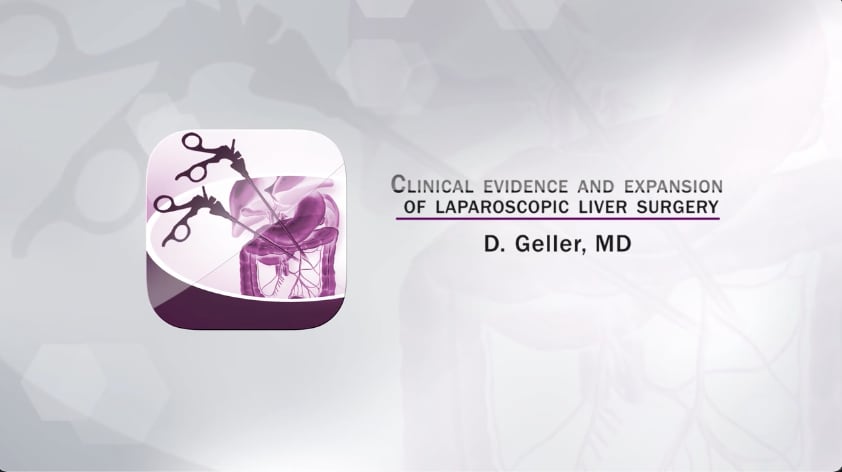Clinical evidence and expansion of laparoscopic liver surgery
David Geller
Laparoscopic liver resection has rapidly expanded, with more than 10,000 cases performed worldwide (1,2).
While early studies described non-anatomic resection of benign liver lesions in anterior segments or the left lateral segment, now many large series have been published with laparoscopic major hepatectomy (3-5) and for cancer.
In a world review published in 2009, there were 2,804 reported cases of laparoscopic liver resection, with over 50% for malignancy (1). Mortality was 0.3% (9/2,84 cases).
Since that time, the number of laparoscopic liver resections has more than tripled, with nearly 10,000 cases reported (2). In a review of 9,527 cases, 6,190 were for malignancy with 50% for HCC and 25% for metastatic colorectal cancer (2). In a survey on the global diffusion of minimally invasive liver surgery, laparoscopic liver resection has been reported in more than 40 countries, with over 100 cases/center being reported in about a dozen centers in U.S.A, Europe, and Asia (6).
Indications
Indications have expanded beyond HCC and metastatic colorectal cancer, and more technically challenging operations such as posterior-superior segments are being reported (7).

Surgical techniques
Surgical techniques for laparoscopic liver resection include pure laparoscopic, hand-assisted laparoscopic, and laparoscopic-assisted “hybrid” approaches where the operation is started laparoscopically and parenchymal transection completed through a small open incision (8). Robotic liver resection has been reported by several groups, but the robotic approach is not cost-effective, and benefits over pure laparoscopic approach remain controversial (9, 10).
Advantages of laparoscopy
The clinical advantages of laparoscopic resection include smaller incisions, less blood loss, and decreased pRBC transfusions, as well as decreased narcotic requirements, shorter length of stay, and diminished post-operative morbidity compared to open hepatic resection (11). A NSQIP propensity score match analysis of 609 laparoscopic vs. 609 open hepatectomies showed that the lap group had lower need for pRBC transfusion, less surgical site infection (SSI), lower post-hepatectomy liver failure, lower rate of bile leak, and shorter length of stay (12).
Oslo-COMET study
The first randomized clinical trial of laparoscopic vs. open liver resection was recently reported as the Oslo-COMET study. In this study, 280 patients with resectable colorectal cancer liver metastases from colorectal were randomized to laparoscopic (n = 133) or open (n = 147) parenchyma-sparing liver resection. The laparoscopic group had significantly less postoperative complications, and shorter length of stay (13). There was no differences in blood loss, operation time, and resection margins, or 90-day mortality.
ORANGE II RCT
The ORANGE II RCT comparing open and laparoscopic left lateral sectionectomy in an ERAS setting was stopped prematurely due to slow accrual, and was not able to reach a conclusion on time to functional recovery (14).
Cost-effective
Laparoscopic liver resection has been shown to be cost-effective. Using a deviation based cost modeling, 44 left lateral sectionectomies were compared to 29 open cases (15). The lap group had a shorter length of stay, less post-op morbidity, and an actual hospital cost savings of $ 2.939/case compared to open liver resection. In a summary from the 2nd International Consensus Conference on Laparoscopic Liver Resection, the comparative costs of laparoscopic and open liver resection was reported (16). Using 12 comparative studies, a median cost savings of 17% was seen with the laparoscopic group compared to open liver resection.
Learning curve
The learning curve for laparoscopic liver resection has been reported by several groups (17-23). The learning curve is defined as “Improvement in performance over time” or “The change in the ability to complete a task until failure is reduced to a constant minimum acceptable rate” (20). There are several important points to consider for laparosocpic liver learning curve papers. Most common learning curve parameters are OR time, conversions, blood loss, or morbidity. Some lap learning curve papers report on one of these parameters, but not others. The learning curve will vary depending on case degree of difficulty, and prior laparoscopic liver resection experience. Most papers use the technique of cumulative sum analysis (CUSUM) to analyze the data. For laparoscopic major hepatectomy cases, the CUSUM # of cases varies depending on whether you include all laparoscopic liver resection cases or just major cases.
In an analysis of laparoscopic resections over 3 time periods, Vigano et al. reported the proportion of laparoscopic major hepatectomy, conversion rate, OR time, blood loss, morbidity, and use of pedical clamping all improved over time (17). Using CUSUM analysis for conversionsm they reported a learning curve of 60 cases for laparoscopic minor hepatectomy. In a four center European study, the learning curve for OR time in laparoscopic left lateral sectionectomy was reported at 15 cases, but this corresponded to the 29th, 44th, 55th, & 55th lap liver resection cases in each of the 4 centers (21). In another study, the learning curve for OR time using CUSUM analysis in 173 lap. major hepatectomy cases was examined in three phases. The learning curve for OR time plateaued in the intermediate phase between 45 and 75 cases (20). In a study of 159 lap. hemi-hepatectomy cases (105 right / 54 left) the risk-adjusted CUSUM analysis for conversions showed a learning curve of 55 cases (19).
Summary
In summary, the most common laparoscopic liver resection learning curve parameters are OR time, conversions, bleeding, & morbidity.
The learning curve for laparoscopic liver resection is 15-20 cases for lap. left lateral sectionectomy, 25-40 cases for minor resection, and 45-70 cases for major hepatectomy.
Three phases exist within the learning curve for laparoscopic liver resection, being the intial phase, intermediate phase, and standardization or mastery phase. As a surgeon or team advances through these phases, the learning curve parameters may have periods of improvement and regression as more difficult cases are done until mastery is achieved. In theory, training programs should be able to shorten learning curve compared to “self-taught” surgeons by standardizing the procedures.